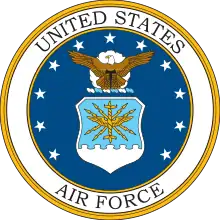920th Rescue Wing
The 920th Rescue Wing is part of the Air Reserve Component (ARC) of the United States Air Force. The wing is assigned to the Tenth Air Force of the Air Force Reserve Command (AFRC).
920th Rescue Wing
 | |
|---|---|
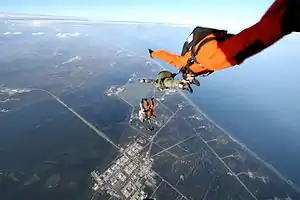 Members of the 920th Rescue Wing conducting freefall training over Cape Canaveral Air Force Station | |
| Active | 1963–1965; 1973–1983; 1997–present |
| Country | |
| Branch | |
| Type | Wing |
| Role | Air Rescue |
| Size | 1,500 personnel |
| Part of | Air Force Reserve Command |
| Garrison/HQ | Patrick Space Force Base, Florida |
| Decorations | Air Force Outstanding Unit Award |
| Commanders | |
| Current commander | Colonel John Dobbin[1] |
| Insignia | |
| 920th Rescue Wing emblem (approved 26 September 1984)[2] | 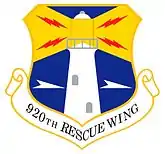 |
| Aircraft flown | |
| Multirole helicopter | HH-60G Pave Hawk |
| Transport | HC-130J Hercules COMBAT KING II |
The 920 Rescue Wing is stationed at Patrick Space Force Base, Florida, with additional geographically separated units consisting of the 943d Rescue Group at Davis-Monthan Air Force Base, Arizona; the 304th Rescue Squadron at Portland Air National Guard Base, Oregon; and the 920th Aerospace Medicine Squadron at Joint Base Langley-Eustis, Virginia. If mobilized to active duty with the Regular Air Force, the wing is operationally gained by the Air Combat Command (ACC).
Overview
Headquartered at Patrick Space Force Base, Florida, the 920th Rescue Wing is the Air Force Reserve Command's premier combat search and rescue (CSAR) unit. The wing consists of over 1,500 Airmen, trained and equipped to locate and recover U.S. Armed Forces personnel during both peacetime and wartime military operations. Additional missions have included manned spaceflight support, such as providing rescue support for NASA Space Shuttle missions during that program's operation; providing search and rescue support for civilians who are lost or in distress; and lending support in humanitarian and disaster relief operations with the wing's HH-60G Pave Hawk and, until December 2019, HC-130P/N Hercules COMBAT KING aircraft.[3] With retirement of its last HC-130P/N, the 920th is transitioning to the HC-130J Hercules COMBAT KING II, with the wing's first HC-130J arriving on 2 April 2020.[4]
In addition to its aircraft squadrons in Florida and an additional aircraft squadron with its subordinate 943d Rescue Group in Arizona, the 920th has three additional rescue squadrons in Florida, Arizona and Oregon consisting of Combat Rescue Officers and enlisted Pararescuemen, the latter known as PJs. While many CROs and PJs enter the 920th from the active duty Air Force, others are accessed directly into the Air Force Reserve. CRO and PJ Candidates must pass a physical assessment test which has about 15% success rate. An average of eighty people Air Force-wide enter the 2-year CRO / PJ training program each year.[5] The CRO / PJ team, along with enlisted Survival, Evasion, Resistance and Escape (SERE) experts, is collectively known as GUARDIAN ANGEL.[6]
The 920th also has an additional squadron consisting of aerospace medical personnel as a geographically separated unit (GSU) based in Virginia.
The 920 RQW was involved in the famous 'Lone Survivor' Operation Red Wings mission, that rescued Navy Seal Marcus Luttrell in Afghanistan and helped in the recovery operation to retrieve the remains of Luttrell's fallen SEAL team. Since 1956, the 920th Rescue Wing has saved more than 3,800 lives, including 850 combat rescues and 3,000 peacetime rescues, such as the 1043 lives the wing saved during Hurricanes Katrina and Rita.[7]
Units
|
|
Geographically Separated Unit (GSU) – Portland International Airport
|
Operations
NASA Manned Space Flight Support:
- Project Mercury (1961–1963)
- Project Gemini (1965–1966)
- Project Apollo (1968–1972)
- Project Skylab (1973–1974)
- Apollo-Soyuz Test Project (1975)
- Space Transportation System (Space Shuttle) (1981–2011)
Disaster Relief:
- Hurricane Andrew Relief Operations (1992)
- Hurricane Katrina Relief Operations (2005)
History
Need for reserve troop carrier groups
During the first half of 1955, the Air Force began detaching Air Force Reserve squadrons from their parent wing locations to separate sites. The concept offered several advantages. Communities were more likely to accept the smaller squadrons than the large wings and the location of separate squadrons in smaller population centers would facilitate recruiting and manning. Continental Air Command (ConAC)'s plan called for placing Air Force Reserve units at fifty-nine installations located throughout the United States. When these relocations were completed in 1959, reserve wing headquarters and wing support elements would typically be on one base, along with one (or in some cases two) of the wing's flying squadrons, while the remaining flying squadrons were spread over thirty-five Air Force, Navy and civilian airfields under what was called the Detached Squadron Concept.[11]
Although this dispersal was not a problem when the entire wing was called to active service, mobilizing a single flying squadron and elements to support it proved difficult. This weakness was demonstrated in the partial mobilization of reserve units during the Berlin Crisis of 1961 To resolve this, at the start of 1962, ConAC determined to reorganize its reserve wings by establishing groups with support elements for each of its troop carrier squadrons. This reorganization would facilitate mobilization of elements of wings in various combinations when needed. However, as this plan was entering its implementation phase, another partial mobilization occurred for the Cuban Missile Crisis, with the units being released on 22 November 1962. The formation of troop carrier groups occurred in January 1963 for units that had not been mobilized, but was delayed until February for those that had been.[12]
Activation of 920th Troop Carrier Group
As a result, the 920th Troop Carrier Group was established at Memphis Municipal Airport, Tennessee, on 11 February 1963 as the headquarters for the 702d Troop Carrier Squadron, which had been stationed there since November 1957.[13] Along with group headquarters, a Combat Support Squadron, Materiel Squadron and a Tactical Infirmary were organized to support the 702d.
The group's mission was to organize, recruit and train Air Force Reserve personnel in the tactical airlift of airborne forces, their equipment and supplies and delivery of these forces and materials by airdrop, landing or cargo extraction systems. The group was equipped with Fairchild C-123 Providers for Tactical Air Command airlift operations.
The 920th was one of three groups assigned to the 445th Troop Carrier Wing in 1963,[14] the others being the 918th Troop Carrier Group at Dobbins Air Force Base, Georgia, and the 919th Troop Carrier Group at Memphis Municipal Airport, Tennessee. The group continued training with Providers at Memphis until it was inactivated in 1965.
Tactical airlift and weather reconnaissance
In 1973 the group was again activated at Keesler Air Force Base, Mississippi, as the 920th Tactical Airlift Group and equipped with Lockheed C-130 Hercules aircraft as part of the 459th Tactical Airlift Wing. In 1973 it was redesignated as the 920th Weather Reconnaissance Group and it then flew weather reconnaissance missions with WC-130 Hercules aircraft, including flying into hurricanes from 1976 to 1983 as part of the 403d Rescue and Weather Reconnaissance Wing at Keesler.[2]
Air rescue
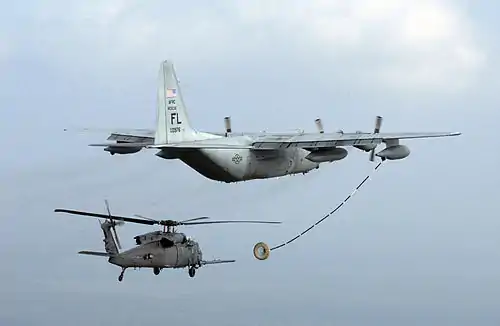
In January 1993, the 301st Rescue Squadron moved from its former base at Homestead Air Force Base, which had been devastated by Hurricane Andrew, to Patrick Air Force Base.[15][16] In April 1997, the rescue mission at Patrick expanded as the group was reactivated as the 920th Rescue Group, forming a headquarters for the 301st and the 39th Rescue Squadron as the helicopter and fixed wing elements of the 301st Squadron were formed into separate units.[2]
In one day in March 1993, the group saved 93 elderly residents from rising flood waters at their Tampa area retirement community. The 920th routinely searches the Caribbean for downed aircraft and retrieves critically ill sailors from ships hundreds of miles out in the Atlantic. Most recently, airmen of the 920th Rescue Wing, with aid from the U.S. Coast Guard, made a daring rescue of 28 British seamen from their sinking merchant vessel 270 miles off the east coast of Florida. In 2005, the wing's HC-130 and HH-60 flight crews recorded more than 1,000 lives saved during disaster operations along the Louisiana/Mississippi/Alabama Gulf Coast in the wake of Hurricane Katrina. The wing's flight crews fly in weather conditions which often test man and machine or at night using night-vision goggle (NVG) technology. The 920th completes arduous, over-water rescues which frequently require the unit's HH-60G Pave Hawk helicopters to be mid-air refueled by their HC-130P Hercules aircraft – a capability not shared by the U.S. Coast Guard's HH-60J and MH-60T Jayhawk helicopters.
The wing is also fully integrated into the Air Force's Air and Space Expeditionary Force and previously deployed personnel and equipment to the former Naval Air Station Keflavik, Iceland on a routine basis in support of NATO operations, and to various locations in Southwest Asia (to include combat zones in Iraq and Djibouti) in support of Operation Desert Storm, Operation Southern Watch, Operation Enduring Freedom and Operation Iraqi Freedom.
In 2003 the group became the 920th Rescue Wing and became the parent unit for all combat search and rescue organizations in Air Force Reserve Command as it added the 943d Rescue Group on the west coast.
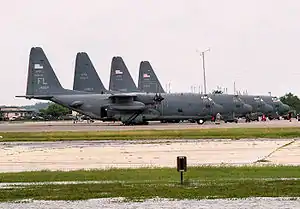
In 2004, the wing's Regular Air Force associated command was briefly reassigned from Air Combat Command to Air Force Special Operations Command. This was done as part of a USAF and DoD Joint Personnel Recovery Agency initiative to merge all USAF combat search and rescue assets and USAF special operations fixed-wing and rotary-wing airborne infiltration/exfiltration, helicopter air refueling, and combat search and rescue assets into a single command. However, command and control issues unique to the special operations community made it apparent that this was not a preferred arrangement, and in 2006, all combat search and rescue assets in AFSOC were aligned under Air Combat Command as the gaining command in the Continental United States and under Pacific Air Forces foir units in the Alaska Air National Guard.
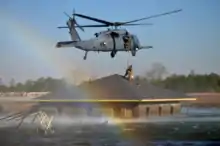
In 2005, the wing provided extensive rescue and humanitarian support along the U.S. Gulf Coast following Hurricane Katrina, this less than 48 hours following the return of a significant portion of the wing's assets from an AEF deployment to Djibouti. Most recently (FY 2008), three of the 920th Rescue Wing's subordinate squadrons, the 39th, 301st and 308th Rescue Squadrons, led military units engaged in civilian rescue and relief for recent hurricane-related disasters in southeast Texas, Louisiana, and parts of Mississippi to include Keesler Air Force Base, Mississippi. Both Hurricanes Hannah and Ike wreaked havoc upon these states, with the 301st Squadron providing support with HH-60G Pave Hawk helicopters, the 39th Squadron with HC-130P Hercules aircraft and the 308th Squadron providing pararescue support.
Members of the 920th Rescue Wing were honored in January 2018 in the International Maritime Museum Hamburg in Hamburg after saving two German citizens, whose vessel caught fire in July 2017 about 500 nautical miles off of Cape Canaveral. The medal is the organization’s highest recognition awarded to individuals, crews or organizations who either took part in the rescue of Germans, or to German crews who took part in a rescue under extremely difficult or challenging circumstances. The German Maritime Search and Rescue Service presented the 920th Rescue Wing with the Medal of Honor for Rescue in Distress in a special ceremony.[17] On 7 August 2017 the wing retired its last HC-130P Combat King when it was flown to Davis-Monthan AFB.[18] The HC-130J Combat King II is now flown by the unit.[4]
Lineage
- Established as the 920th Troop Carrier Group, Assault and activated on 15 January 1963 (not organized)
- Organized in the reserve on 11 February 1963
- Discontinued and inactivated on 15 December 1965
- Redesignated 920th Tactical Airlift Group on 2 March 1973
- Activated in the reserve on 25 April 1973
- Redesignated 920th Weather Reconnaissance Group on 1 January 1976
- Inactivated on 1 November 1983
- Redesignated 920th Rescue Group on 1 April 1997
- Activated in the Air Force Reserve on 15 April 1997
- Redesignated 920th Rescue Wing on 1 April 2003[2]
Assignments
- Continental Air Command, 15 January 1963 (not organized)
- 445th Troop Carrier Wing (later 445th Air Transport Wing, 445th Military Airlift Wing), 11 February 1963 – 15 December 1965
- 459th Tactical Airlift Wing, 25 April 1973
- Eastern Air Force Reserve Region, 1 January 1976
- Western Air Force Reserve Region, 15 February 1976
- Fourth Air Force, 1 October 1976
- 403d Rescue and Weather Reconnaissance Wing, 1 January 1977
- Fourth Air Force, 1 July 1981
- 403d Rescue and Weather Reconnaissance Wing, 1 March – 1 November 1983
- Tenth Air Force, 15 April 1997
- 939th Rescue Wing, 16 April 1997
- Tenth Air Force, 1 Apr 2003 – present[2]
Components
- Groups
- 920th Operations Group: 1 April 2003 – present[2]
- 920th Maintenance Group: 1 April 2003 – present[19]
- 920th Mission Support Group: 1 April 2003 – present[19]}
- 943d Rescue Group: 12 February 2005 – present[2]
- Squadrons
- 39th Rescue Squadron: 15 April 1997 – 1 April 2003[2]
- Shifted to 920th Operations Group on 1 April 2003
- 301st Rescue Squadron: 15 April 1997 – 1 April 2003[2]
- Shifted to 920th Operations Group on 1 April 2003
- 308th Rescue Squadron: 15 April 1997 – 1 April 2003
- Shifted to 920th Operations Group on 1 April 2003
- 920th Operations Support Squadron: 15 April 1997 – 1 April 2003
- Shifted to 920th Operations Group on 1 April 2003
- 702d Troop Carrier Squadron: 11 February 1963 – 15 December 1965[2]
- 815th Tactical Airlift Squadron (later 815th Weather Reconnaissance Squadron): 25 April 1973 – 1 November 1983[2]
- 920th Aerospace Medicine Squadron: 5 Aug 2012 – present[19] (previously designated 920th Aerospace Medicine Flight)
- Joint Base Langley-Eustis, Virginia
- Flights
- 34th Air Weather Flight: 1 January 1980 – 1 November 1983[21]
Stations
- Memphis Municipal Airport, Tennessee, 11 February 1963 – 15 December 1965
- Keesler Air Force Base, Mississippi, 25 April 1973 – 1 November 1983
- Patrick Space Force Base, Florida, 15 April 1997 – present[2]
Aircraft
- Fairchild C-123 Provider (1963–1965)
- Lockheed C-130 Hercules (1973–1977)
- Lockheed WC-130E/H Hercules (1976–1983)
- HC-130P/N Hercules Combat King (1974–2019)
- HC-130J Hercules Combat King II (2 April 2020 – present)[4]
- HH-60G Pave Hawk (1997–present)[2]
References
Notes
- Components are stationed with wing headquarters, except as noted.
Citations
- "920th Rescue Wing to Welcome New Commander at Change of Command Ceremony". Retrieved 1 April 2020.
- Robertson, Patsy (13 May 2008). "Factsheet 920 Rescue Wing (AFRC)". Air Force Historical Research Agency. Retrieved 16 July 2016.
- https://www.920rqw.afrc.af.mil/News/Article-Display/Article/2050896/the-end-of-an-era/
- "Super Herculean Milestone". Retrieved 11 April 2020.
- Moody, R. Norman (10 October 2010). "Parachute jumpers' journey begins at Patrick". Melbourne, Florida: Florida Today. pp. 1A.
- https://www.af.mil/About-Us/Fact-Sheets/Display/Article/104472/guardian-angel/
- "920th Rescue Wing recalls 'Lone Survivor' mission". Retrieved 1 April 2020.
- "Units". www.920rqw.afrc.af.mil. Retrieved 16 February 2017.
- "Rescue Wing activates new flight". 920th Rescue Wing. Retrieved 16 February 2017.
- "920TH RESCUE WING UNITS". Retrieved 1 April 2020.
- Cantwell, pp. 156, 169
- Cantwell, pp. 189–191
- Maurer, pp. 707–708
- Ravenstein, pp. 241–242
- https://www.afhra.af.mil/About-Us/Fact-Sheets/Display/Article/432127/301-rescue-squadron-afrc/
- Defense Base Closure and Realignment Commission: 1995 Report to the President, Ch.1, pp. 1–90 – 1–92
- Maurice, Lindsey (26 January 2018). "Reserve wing receives prestigious German Maritime Search and Rescue award". 920th Rescue Wing Public Affairs. Retrieved 30 January 2018.
- "Wing bids farewell to last HC-130P model". Retrieved 1 April 2020.
- https://www.920rqw.afrc.af.mil/Units/
- 920th Rescue Wing – 943 Rescue Group. 920rqw.afrc.af.mil. Retrieved on 2013-09-18.
- https://books.google.com/books?id=M84-F1y3MicC&pg=PT52&lpg=PT52&dq=34th+air+weather+flight&source=bl&ots=VHfiNl9k5-&sig=ACfU3U21XL1H5Zx7lZv6WoZIV39rJRixPw&hl=en&ppis=_e&sa=X&ved=2ahUKEwjFx6HywM3nAhVMnFkKHfQPCjUQ6AEwAHoECAkQAQ#v=onepage&q=34th%20air%20weather%20flight&f=false
Bibliography
![]() This article incorporates public domain material from the Air Force Historical Research Agency website http://www.afhra.af.mil/.
This article incorporates public domain material from the Air Force Historical Research Agency website http://www.afhra.af.mil/.
- Ravenstein, Charles A. (1984). Air Force Combat Wings, Lineage & Honors Histories 1947–1977. Washington, DC: Office of Air Force History. ISBN 0-912799-12-9.
